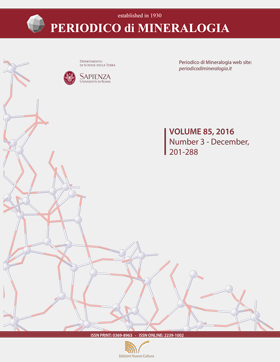Fluid inclusion studies on Cu–Mo–Au bearing quartz–sulphide veins and veinlets in Qarachilar area, Qaradagh pluton (NW Iran)
DOI:
https://doi.org/10.2451/2016PM658Keywords:
Qarachilar, Qaradagh pluton, Fluid inclusion, Microthermometry, Salinity, Homogenization temperature.Abstract
The Qaradagh pluton is located in NW Iran. It is comprised of Eocene–Oligocene intrusive pulses and hosts hydrothermal alterations and vein-type Cu–Mo–Au mineralization, which is more manifested at Qarachilar area (central part of the Qaradagh pluton). This study aims to elucidate the physic–chemical characteristics of the ore-bearing fluid using microthermometric studies on quartz–sulphide veins/veinlets. Microthermometric analyses show that the salinity of ore-bearing fluid is about 15–65 wt% NaClequiv, with the highest frequency between 25 and 45 wt% NaClequiv. The homogenization temperature for primary 2-phase and multiphase inclusions ranges about 220–540°C. Most of the 2-phase inclusions homogenize by vapor disappearance with TH(L-V) values between 280 and 440°C. Most of the multiphase inclusions homogenize by simultaneous disappearance of vapor bubble and dissolution of halite daughter crystal, for which the TH value is 240–420°C. The data-points trend in TH(L-V)–Salinity plot indicates the occurrence of boiling of low-salinity fluids and dilution by superficial fluids. The minimum pressure at the time of fluid entrapment is estimated about 50 to 120 bars, equivalent to the hydrostatic depths of 500 to 1100 m.


